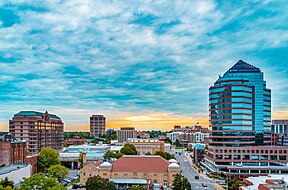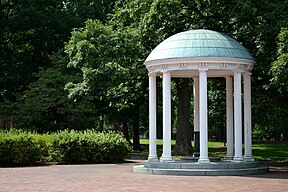
Back Research Triangle German Área metropolitana de Raleigh-Cary Spanish مثلث تحقیقاتی Persian Research Triangle Finnish Raleigh-Durham French リサーチ・トライアングル Japanese ریسرچ ٹرائی اینگل Urdu
Research Triangle | |
|---|---|
Representations of the Research Triangle (from top to bottom): skyline of Raleigh, skyline of Durham, and the Old Well in Chapel Hill | |
 | |
| Country | |
| State | |
| Largest city | Raleigh |
| Other cities | Durham Chapel Hill Cary |
| Area | |
• Total | 4,766 sq mi (12,340 km2) |
| Population (2020) | |
| • Density | 442/sq mi (171/km2) |
| • CSA | 2,106,463 (32nd) |
| GDP | |
| • Raleigh–Durham–Cary (CSA) | $183.624 billion (2022) |
| • Raleigh (MSA) | $119.675 billion (2022) |
| • Durham-Chapel Hill (MSA) | $63.950 billion (2022) |
| Time zone | UTC−5 (EST) |
| • Summer (DST) | UTC−4 (EDT) |
| Area code(s) | 919, 984 |
The Research Triangle, or simply The Triangle, are both common nicknames for a metropolitan area in the Piedmont region of the U.S. state of North Carolina. Anchored by the cities of Raleigh and Durham and the town of Chapel Hill, the region is home to three major research universities: North Carolina State University, Duke University, and the University of North Carolina at Chapel Hill, respectively. The "Triangle" name originated in the 1950s with the creation of Research Triangle Park located between the three anchor cities, which is the largest research park in the United States and home to numerous high tech companies.[4]
The nine-county region, officially named the Raleigh–Durham–Cary, NC Combined Statistical Area by the Office of Management and Budget, comprises the Raleigh–Cary, Durham–Chapel Hill, and Henderson, NC Metropolitan Statistical Areas. The 2020 census put the population of the area at 2,106,463, making it the second-largest combined statistical area in North Carolina, behind Charlotte.[5] The Raleigh–Durham television market includes a broader 24-county area which includes Fayetteville, North Carolina, and has a population of 2,726,000 persons.[6] Most of the Triangle is part of North Carolina's first, second, fourth, ninth, and thirteenth congressional districts.[7]
The region is sometimes confused with the Piedmont Triad, which is a North Carolina region adjacent to and directly west of the Triangle comprising Greensboro, Winston-Salem, and High Point, among other cities. Both the Research Triangle and the Piedmont Triad form part of the Piedmont Crescent, a heavily urbanized region of the state that includes the city of Charlotte.
- ^ "Total Gross Domestic Product for Raleigh, NC (MSA)". fred.stlouisfed.org.
- ^ "Total Gross Domestic Product for Durham-Chapel Hill, NC (MSA)". fred.stlouisfed.org.
- ^ "GDP by county in 2021" (PDF). www.bea.gov.
- ^ "The Research Triangle Park". Rtp.org. Archived from the original on 2013-05-24. Retrieved 2013-05-16.
- ^ "Metropolitan and Micropolitan Statistical Areas Population Totals: 2010–2019". U.S. Census Bureau. Retrieved 2020-03-29.
- ^ Nielsen Station Index, Viewers in Profile, Raleigh–Durham (Fayetteville), NC May 2010
- ^ Rakich, Ryan Best, Aaron Bycoffe and Nathaniel (2021-08-09). "What Redistricting Looks Like In Every State - North Carolina". FiveThirtyEight. Retrieved 2022-05-23.
{{cite web}}: CS1 maint: multiple names: authors list (link)


